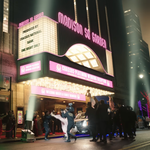
Pino Palladino has served as the final, lanky puzzle piece for innumerable songs over the past four decades. Even the bassist himself is unsure of the exact tally. It’s definitely in the high hundreds, maybe thousands. “I’ve heard a lot of people say that they can recognize me within a few notes, which is a huge compliment,” Palladino says. “That’s what we all hope for as musicians, to have some sort of individual sound.” A fun game is to open this incomplete Spotify playlist, think of a random number, and see which songs he has played on. My most recent round: 242 is “Come to My Window,” by Melissa Etheridge, and 163 is “Do You Remember?,” by Phil Collins.
Palladino, who hails from Wales, doesn’t have a defined way of working in the studio. He and his menagerie of basses have been summoned at every stage of the creative process, and he says his method depends entirely on the song, the producer, and the state the song is in. Whether he’s working with longtime collaborators John Mayer, the Who, and D’Angelo, or in single sessions with Adele, Elton John, and Erykah Badu, everything in his oeuvre possesses a trademark reverence. “What I tell myself when I’m going to play on a song is ‘Just don’t ruin it,’” Palladino says. “But in all seriousness, I treat all the music I play on with the same respect and try to give it integrity. I like to dip into different genres and be respectful to that genre but also bring a little of myself into it.” In the midst of a short residency at New York’s Blue Note, Palladino shared the stories behind the bass lines he considers among the toughest and most significant of his career.
Don Henley, “Sunset Grill” (1984)
The first song I played on for Don Henley was “Sunset Grill,” which was on Building the Perfect Beast. Don’s production partner at the time, Danny Kortchmar, is an incredible guitar player and producer who was also in a famous studio band called the Section. I was told Danny was driving in Los Angeles and Nick Heyward’s “Whistle Down the Wind” came on the radio. It featured a little bass solo from me on it. It was rare for pop songs to have bass solos, and it surely doesn’t happen anymore. He heard this song and thought, “Oh my God, who’s playing the bass on this?” He told Don, and Don apparently made a bunch of calls to identify who I was. He finally found me and left an answering-machine message: “Hey, Pino, this is Don Henley, please give me a call. I’d love you to come and play on a song for me.” I thought it was a joke and almost deleted the message. I really couldn’t believe I would get a personal call from Don Henley.
I was on tour with Paul Young in New York City, and I didn’t know when I was going to do the session for Don until the very last show. My bass, gear, and equipment were already on a ship back to London by the time I knew I had to fly to Los Angeles. So I had to go into a music store in New York and buy a new fretless bass. I remember Don asking me on the phone, “You’ve got that fretless bass, right?” I kind of lied. I went, “Yeah, sure.” I desperately ran over to Sam Ash on 48th Street and looked for a fretless bass, and luckily they had one in, which was a Pedulla Buzz. I still have it.
So that led to me flying over to Los Angeles. He played “Sunset Grill,” and it was made for me. They left a lot of space for the bass. Don was involved in every note choice. We used different bits from different performances and put them all on one track. I feel that song, once it was finished and people heard it, led to me working in America a bit more. It was quite rare for British musicians to cross over the water. It’s not like America doesn’t have enough amazing musicians.
Pete Townshend, “Give Blood” (1985)
After my initial move to London to play with Jools Holland in his band — and once the sound of my bass was heard on the radio — David Gilmour from Pink Floyd reached out to me, which was unbelievable. He asked me to play on his album About Face. There was a song he and Pete Townshend had collaborated on. When Pete wanted to cut it, he called me in and said, “David’s recommended you, would you come and play?” It was called “White City Fighting.” So I turned up in the studio. I’d never met Pete, and obviously he’s one of my heroes. I played on that first song, pretty nervous, and then after a while Pete said, “There’s another song that we’ve been messing with. It’s got David’s guitar through a sort of an echo unit.” Pete wasn’t sure what to do with it, and he asked me what I thought about it. That song turned out to be “Give Blood.”
As soon as I heard what he had, I was like, “Please let me at it, I would love to play on this.” I opened up the bass and we cracked it together. I remember it being a watershed moment for me. I left it all out there. That was a very important session for me because that’s where my connection with Pete began. Sometimes there’s not much talk between us. You do this sort of polite conversation, everyone tries to make everyone else feel at ease, and then you get on with the music. That’s our musical communication. It’s like a switch with musicians. You connect through the music and you are always connected after that. It only takes one song.
Paul Young, “Every Time You Go Away” (1985)
I have a lot of history with Paul Young. We had done his second album, The Secret of Association, and it was deemed by executives after we finished the record that there wasn’t a strong enough single. It was Paul’s idea to do a cover of “Every Time You Go Away” and try to make it a hit. I remember going to the studio and they had laid down the backing track with the drums, some keyboard pads, and a guide vocal, and they just let me loose on it. We spent the good part of a day constructing the bass lines. I knew what I wanted to play, and the fretless bass became a big part of Paul’s sound. Paul asked me, “Do you want to hear the original from Hall & Oates?” I said, “Well, no.” The point is if you don’t know the original and you hear what you’re going to play, you don’t have any preconceived ideas of what it needs to do. It was an open book for me, and I treated it as a chance to come up with some cool bass lines to compliment Paul’s vocals.
B.B. King, “Ain’t Nobody Home” (1997)
I was lucky enough to do Deuces Wild with B.B. King with some sessions in London. We hit it off, and B.B. said, “I’ve also got some sessions in New York next week. Could you come and play bass on those too?” Uh, yeah! I went along and had an amazing band — Steve Jordan playing drums, Leon Pendarvis playing keys, Jimmy McCracklin on guitar, and Jon Cleary on piano. This is as legendary as you can get. Then D’Angelo turned up with Questlove and we decided to cut this song called “Ain’t Nobody Home.” That was another watershed moment for me because that’s when my connection with D’Angelo kicked off. The track was grooving. D’Angelo sang and played piano on it, so it became a duet with B.B. We did one or two takes, and the performance was such that we didn’t need to work too hard on it. B.B. always made it feel like he was playing on your record. I had to keep telling myself, No, it’s okay. Just relax. His whole vibe was very chilled: “Whatever you want to do, I’ll just join you guys.” B.B. was a conduit for my future relationship with D’Angelo. He brought us together, and that led to many years of incredible music.
D’Angelo, “Chicken Grease” (2000)
When I was working with D’Angelo for Voodoo, we were in the studio a couple of days at a time. I would fly in from London, or if I was already in America, I would fly into New York and play. It was piecemeal. There came a point in the record where I was back in London and D’Angelo reached out and said, “Look, P, I’ve got this song. I need you on it.” I was like, “Okay, great. When do you want to do it?” And he said, “Things are a little tight on the financial side.” And I said, “Okay, I’m going to fly myself in on my own dime. Don’t worry about it.” I just thought, Why wouldn’t I take the chance on this? That song he played for me in the studio turned out to be “Chicken Grease.” It was amazing and done within one or two takes. It had a particular feel to it, which both defined my playing and opened my playing up to a lot of people who hadn’t necessarily heard it before, like De La Soul, Erykah Badu, and the whole Soulquarians crew.
That style of music D’Angelo was writing was something he passed on to me — he explained the rhythmic concept of the way he felt music. I identified with it straightaway when we first met. It’s that approach of the bass hanging back on the field along with some of the other instruments. There’s a tension created in the groove that became a thing when Voodoo came out. “Chicken Grease” led me to work on a lot of different music that I perhaps wouldn’t have been invited to play on.
De La Soul, “All Good?” (2000)
One night I was in the studio with D’Angelo. Questlove was with us, and he got a phone call from De La Soul. The guys in the group had seen me performing with D on The Chris Rock Show, where we did a version of “Chicken Grease.” They were interested in getting me to play on one of their songs. I heard Questlove on the phone: “Yeah, Pino’s here now.” He looked at me and asked, “Can you go over and play on this song for De La Soul?” I said, “When?” And he went, “Right now.” I said, “Yeah, sounds good, man.” I rushed over to the studio, and I played on the song, which is called “All Good?” and features Chaka Khan. That was a great track. I was such a fan of hip-hop and being in the studio with De La Soul was fantastic. I did a couple of takes, and it felt good. That’s a really grooving song. I love that shit.
My thing is going in and out of different genres of music and giving the genre the respect it deserves. My history with hip-hop goes back to the reggae and dancehall stuff from the ’70s where I was spending time in clubs in Wales. Bass has a very sparse approach in hip-hop, so I approach it in that way — bass lines that just have a lot of feel. Whereas with rock music or pop music, you can approach the bass in very different ways.
John Mayer, “Vultures” (2007)
Prior to Continuum, I met John Mayer when I was asked to do a charity performance with him. This was through Steve Jordan — he had recommended me. My first impression of John was I felt he was a really great young guitar player. I wasn’t that aware of his first few albums. My wife said to me at one point, “Have you heard of this new guy, John Mayer? He sounds really good. I’m sure you’re going to work with him.” She just had a feeling, which was strange. We did a Jimi Hendrix cover, and as we were rehearsing the day before the performance, the three of us sounded good. Really good. We realized something was happening. John finally wised up and said, “Would you guys be interested in having a band and going out as the John Mayer Trio?” Steve and I thought about it and said, “Sure, let’s try it.” While we were rehearsing for the Trio tour, we didn’t have any songs until we got into rehearsals. We started collaborating on some writing. “Vultures” was one of the songs that came out of that rehearsal. A month or so later, we went into the studio to cut the album with John. The groove Steve played really drove that song. The bass line is very simple, but I felt it needed this rootsy, almost reggae hip-hop approach to match the blues. This moment led me to work with him for many years.
Harry Styles, “Watermelon Sugar” (2019)
There’s a studio in Los Angeles called Henson Studios, which was originally Charlie Chaplin’s lot. It’s quite a historical place. I was rehearsing there with John Mayer for a tour around 2017. I met Harry Styles in that studio. John introduced me to him. While we were rehearsing, Harry would sometimes come and have a listen. He’s a big fan of John’s. Shortly after, I got a call inviting me to play on a couple of songs for Fine Line, the first of which was “Watermelon Sugar.” Harry and his producer played it for me in the studio and the bass line was only partly constructed. You don’t need to reinvent the wheel to make the song sound good — sometimes the best challenge is how less can be more. We had a lot of fun cutting that song. Harry was very encouraging and gave me freedom to express myself through the line that was already there. When things go really well, there’s not much else you can do, as simple as that sounds. It’s amazing to know how many people have heard that song. You could be walking into a shop and it’s playing. It’s a great feeling.





